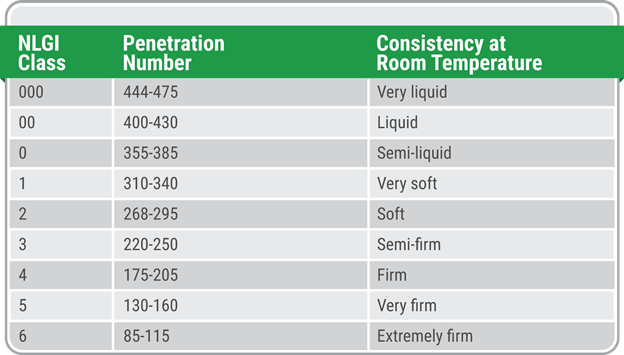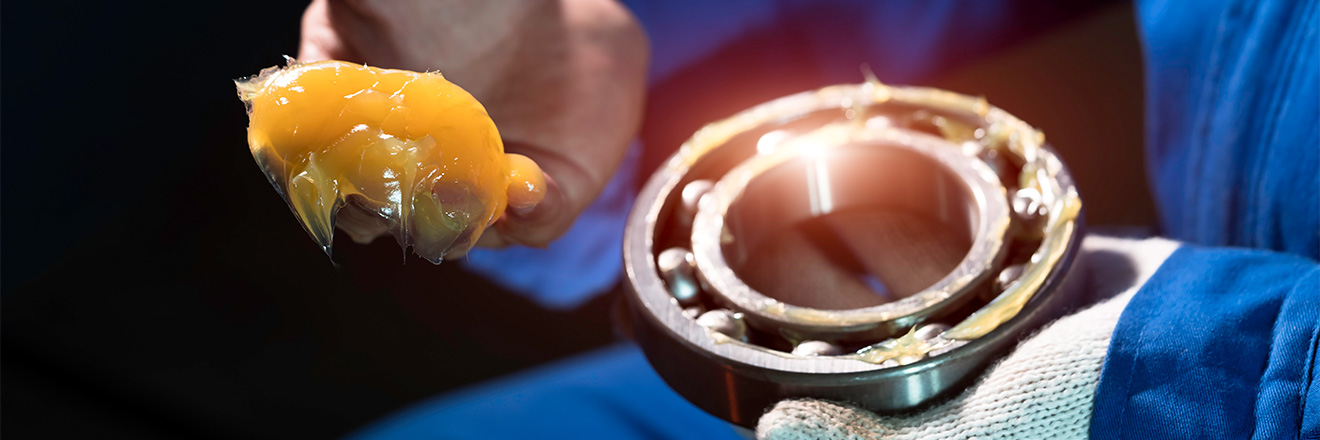The purpose of grease lubrication is to ensure your machines are operating at the highest quality standard possible. By adding the proper grease to your machine maintenance routine, you guarantee your facility is running at peak performance and preventing unnecessary machine shutdowns and damage.
But what is grease lubrication? In this article, we will explain what lubricating grease is and how its components work together to keep your machines running efficiently and your team operating safely.
Grease Anatomy
Proper lubricating grease has three key components - a base oil, a thickener, and additives.
The two largest components of this mix are the base oil and the thickener. Because they carry such weight in the formula, they have significant influence over how the grease will react and behave at any given point.
The additives, while claiming a smaller portion of the equation, play an equally crucial role.
While we will be looking at the components as individuals, it is important to remember they must all work efficiently with one another to ensure the best quality lubrication for your machinery.
Base Oil
There are two basic types of base oil that can be used. Mineral oil is the most common and versatile option for everyday industrial use. While they can provide great results for heavy load applications, its performance can begin to deteriorate under extreme temperatures.
Unlike mineral oils, synthetic oils are best suited for protecting against engine wear in temperature-extreme environments without breaking down. Although they are resistant to heat, a synthetic oil is not always the right fit for your machinery. For instance, synthetic fluids can be harsh on certain types of seals.
It is important to always refer to the Original Equipment Manufacturer (OEM) or a trusted industry professional to help determine the base oil for your equipment.
Thickener
Once you have selected the base oil that best fits your business needs, the next step is to select a thickener. The thickener acts like a sponge, absorbing and holding the lubricating grease together. It also gives the completed mix its structure, which can range from semifluid to firm.
There are three basic types of thickeners - simple metal soaps, complex metal soaps, and non-soaps.
Simple metallic soaps can be made of components such as, lithium, and calcium. This soap is best known for its water resistance, although it has difficulty handling extreme temperature environments.
While simple metallic soaps are a great standard, complex metallic soaps are gaining popularity. Complex soaps are made by reacting multiple components, giving them a higher dropping point and lower oil separation rate. This allows the mix to withstand extreme temperatures.
Non-soap thickeners are commonly made of silica or clay and can have great performance abilities in unfavorable environments.
Additives
The final part of a lubricating grease mix is the additives. Additives are primarily used to enhance existing desirable properties in the grease. They also suppress undesirable properties. Common desirable properties include oxidation resistance, rust resistance, and friction- reduction.
Common desirable-property enhancers include boundary lubricants such as molybdenum disulfide (moly). This ensures that a thin film of lubrication protects the surfaces of moving objects without causing wear or adverse chemical reactions on the metal surface.
Functions of Grease
There are several functions that a quality lubricating grease takes on for your machinery to perform properly.
The basic function of grease is to lubricate and stay in contact with moving surfaces without leaking out under the force of gravity and centrifugal action. Essentially, the grease needs to retain all its properties while being put under the stress of different operating conditions. For example, a construction or mining facility might need a specialized heavy-duty grease to operate certain equipment at peak performance.
A proper grease also needs to protect the machinery from rust, corrosion, and contaminants such as dirt and water.
Applications Suitable for Grease
While oil is a key component in grease lubrications, oil and grease are not interchangeable. Oil can be the right choice for anti-friction lubrication, but it does not have the ability to stay in place under extreme conditions like grease.
Since grease lubrication utilizes a thickener to help achieve proper consistency, it makes it a top choice for machine lubrication. To ensure you are selecting the proper option for your business and operational needs, you should review your machine lubrication needs.
Grease is generally used for:
- Machinery that runs intermittently or is in storage for an extended period. Because grease remains in place, a lubricating film can instantly form.
- Machinery that is not easily accessible for frequent lubrication. High-quality greases can lubricate isolated or relatively inaccessible components for extended periods without frequent replenishing. These greases are also used in sealed-for-life applications such as some electrical motors and gearboxes.
- Machinery operating under extreme conditions such as high temperatures and pressures, heavy weights, shock loads, or slow speeds.
- Worn components. Grease maintains thicker films and can extend the life of worn parts that were previously lubricated by oil.
Functional Properties of Grease
Functional properties, or characteristics, can provide insight into how a specific grease will react with your machines and if it is the correct choice for your lubrication needs. There are four major functional properties of grease to consider.
- Because of its consistency, grease acts as a sealant and helps minimize and prevent lubricant leakage. It can even keep deteriorating seals effective for longer than if left untreated. Grease also blocks corrosive and foreign materials from contaminating your machinery.
- Grease is easier to contain than oil. Oil lubrications often require expensive circulating equipment and complex retention devices.
- While oil lubricants will let solids settle out, grease holds solid lubricants in suspension. Finely ground solid lubricants, such as graphite, are sometimes mixed with grease in high-temperature and high-pressure applications.
- Fluid levels do not have to be controlled and monitored.
Characteristics of Grease
Grease displays its own set of unique characteristics that must be considered when making a final decision on lubrication for your machinery. The characteristics commonly displayed by grease lubricants include:
Pumpability
Pumpability is the ability of a grease to be pumped, or pushed, through a system. It focuses solely on the ease with which the pressurized grease flows through lines, nozzles, and even fittings for grease-disbursement systems.
Water Resistance
Water resistance is the ability of the grease to withstand the effects of water without losing its ability to properly lubricate your machines. Water causes a reduction in the performance of your lubrication to the detriment of your machines. Therefore, a quality grease lubricant is necessary for most equipment.
Consistency
A grease's consistency depends on the type and amount of thickener used, as well as the overall viscosity of the chosen base oil. Consistency deals with the lubricant's ability to not become deformed when pressure or force is applied. The measure for consistency is called penetration.
Penetration focuses on whether the consistency of the grease lubrication has been altered either from handling or the daily workload. There are methods currently used to measure the penetration of either worked or unworked greases, such as ASTM D 217 and D 1403. Essentially, a cone of a specific given weight is submerged into the grease lubricant for five seconds at 25°C (77°F). The depth to which the cone sinks into the grease is the penetration. A penetration of 450 would be semifluid while a penetration of 100 would be firm.
For a grease's consistency, the National Lubricating Grease Institute (NLGI) has established a descriptive consistency grading system ranging from 000 to 6.
The table below illustrates the range of both the consistency and penetration of a lubricating grease.

The National Lubricating Grease Institute (NLGI) divides greases into classification groups based on their consistency.
One way to think about this table is that NLGI Class 000 has a consistency something like ketchup while an NLGI Class 2 might be more like peanut butter. NLGI Class 6 grease is quite firm yet still spreadable-more like a cheddar cheese spread.
Dropping Point
The dropping point is the temperature at which a grease becomes fluid enough to drip, and it is an indicator of the heat resistance of your grease. As grease temperatures rise, penetration increases until the grease softens, and the desired consistency is lost.
The dropping point indicates the upper temperature limit at which the grease retains its structure, not the maximum temperature at which it can be used.
Oxidation Stability
Oxidation stability refers to the ability of a grease to resist a chemical reaction with oxygen. This is typically caused by prolonged exposure to high temperatures, which accelerates oxidation in greases. When greases combine with oxygen, they produce insoluble gums, sludges, and lacquer-like deposits. This can cause sluggish operations, a reduction in clearances, and even increased wear on the machines.
High-Temperature Effects
High temperatures can cause extreme damage to grease lubrications. Grease, by nature, cannot dissipate heat well through convection. Because of its poor ability to transfer away heat, excessive temperatures can cause accelerated oxidation. In extreme cases, it can even cause carbonization, or the hardening of grease, resulting in a crust formation.
Effective grease lubrication depends on the grease's consistency. Excessively high temperatures can also induce softening and bleeding. This causes the grease to flow away from the areas that need it most. Once temperatures rise above 177°C, the oil in the grease can flash, burn, and evaporate.
Low-Temperature Effects
Low temperatures can also negatively impact grease lubrication. If temperatures are lowered enough, the grease will become so viscous that it turns into a hard grease. When this occurs, pumpability suffers and machine operations may become impossible due to the torque limitations and power requirements of the machines.
Conclusion
Accurate lubrication is essential to ensuring your machinery is operating at the highest quality standard possible. By adding a proper lubrication process to your business, you guarantee your facility is performing at the highest, safest levels possible.
References
- Pirro, Wessol. Lubrication Fundamentals. New York: Marcel Dekker, 2001.
- U.S. Army Corps of Engineers. Engineering and Design - Lubricants and Hydraulic Fluids. EM 1110-2-1424 CECW-ET, 1999.
